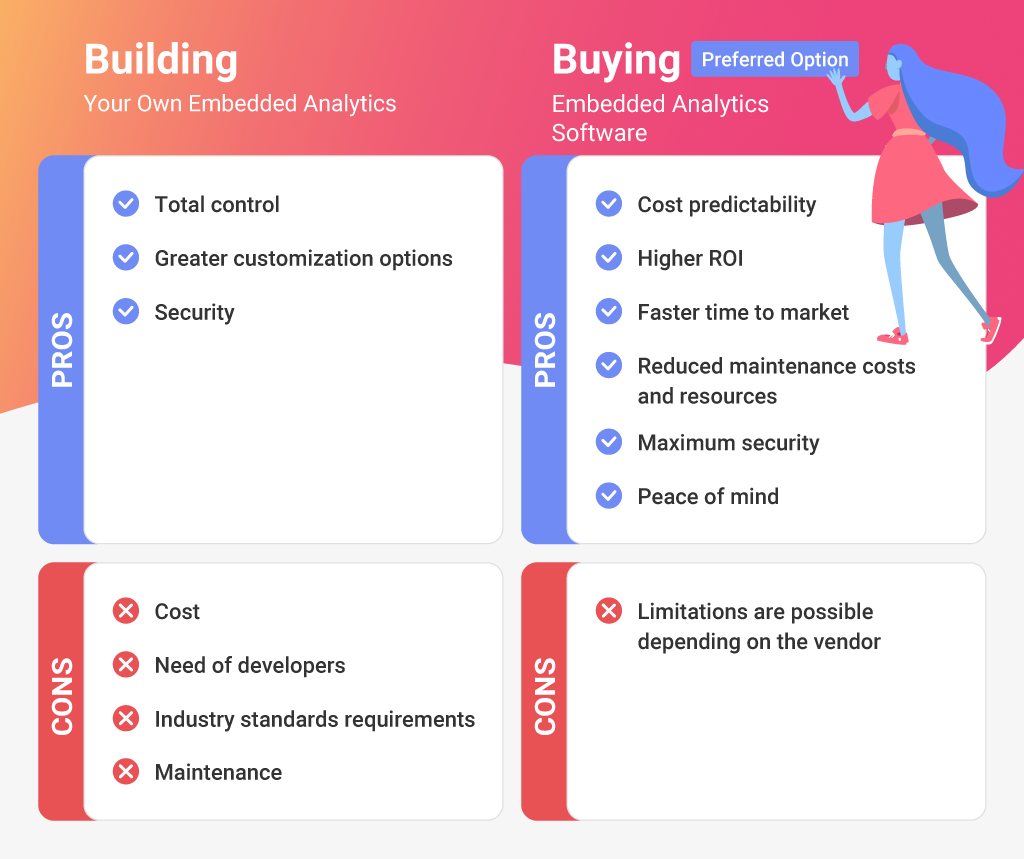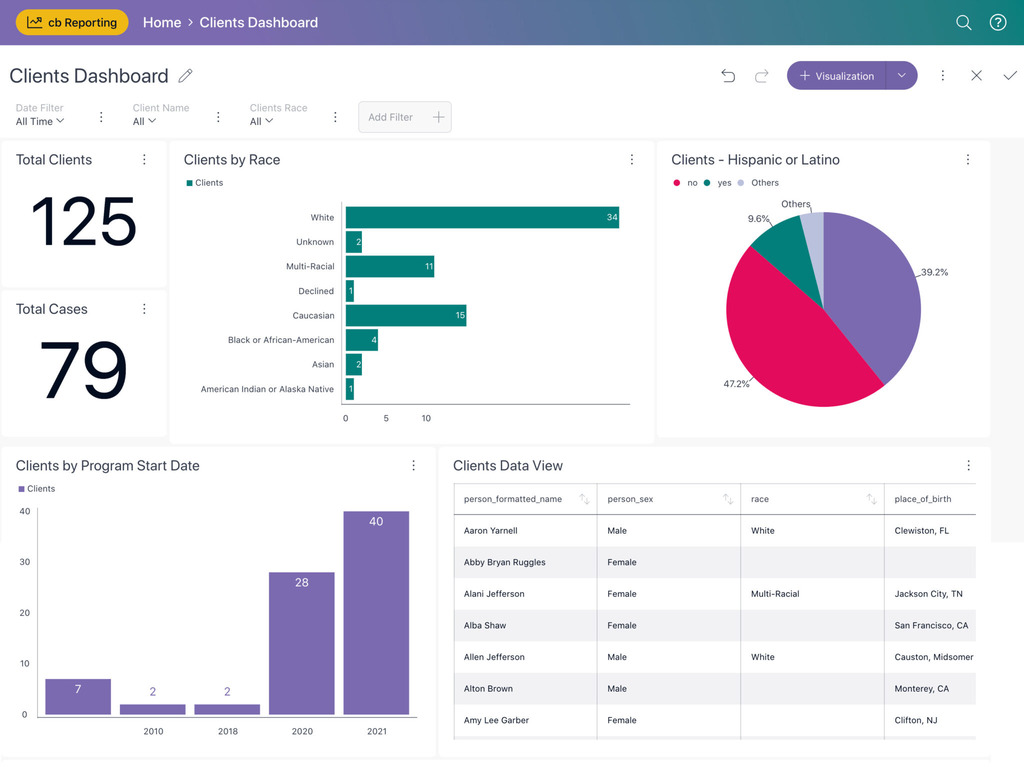
Scriptly Helps Pharmacies Identify Trends in Real Time with Reveal
The best way to deliver insights in your SaaS product is to embed them directly where users work. No switching tools. No report delays. Building analytics in-house burns time and dev resources. Reveal is purpose-built embedded analytics for SaaS platforms, with a true SDK, full white label control, and fixed pricing that scales. You get in-app self-service analytics without slowing down your roadmap.
Executive Summary:
Most SaaS companies collect product data. Few make it usable where it matters—inside the application. That’s where embedded analytics for SaaS changes the equation, giving users direct access to insights without extra tools or delays.
Without it, internal teams chase down report requests, engineers burn cycles maintaining dashboards, and users leave your app to answer simple questions.
This guide demonstrates how product-led teams utilize embedded analytics to enhance engagement, reduce support load, and ship faster without the burden of building from scratch.
SaaS analytics refers to the process of collecting, analyzing, and visualizing data from your SaaS application to improve product performance, enhance user experience, and drive better business outcomes.
Unlike traditional business intelligence (BI) tools, SaaS analytics software is often embedded directly into the application. That means users and internal teams can access real-time insights and make decisions without switching tools, submitting data requests, or waiting on reports.
Some common use cases for embedded analytics for SaaS are:
Scriptly, a SaaS platform for pharmacies, is the perfect example. They used Reveal to surface real-time prescribing trends inside their product. There is no visualization layer to build and no analyst in the loop. Within two weeks, end users were exploring data and making decisions inside the app without switching tools or opening a support ticket.

That’s the whole point: In modern applications, embedded analytics for SaaS is not an afterthought. It’s part of the core product experience. When users can act on insights inside your platform, they move faster and rely more on your product to drive outcomes.
Building analytics in-house feels appealing. It gives you full control, aligns with your tech stack, and avoids vendor lock-in. But those advantages fade fast.
On average, a SaaS company will spend at least 6 months building a custom reporting layer with a full-time dev team. Our estimates suggest that the cost will also be between $350,000 and $500,000.
Despite this colossal investment, in-house embedded analytics often come short, and more often than not, SaaS leaders go for the much more cost-efficient third-party embedded analytics solution.
Here’s why building your own often breaks down:
When it comes to Build vs. Buy, unless analytics is your core product, building it in-house creates more risk than value. That’s why most SaaS leaders shift to embedded analytics for SaaS platforms designed for scale, performance, and seamless product integration.

Your users don’t just want features. They want answers. They expect to see what’s working, monitor key metrics, and make decisions in real time without leaving your product.
Built-in analytics transforms your SaaS platform from a tool into a decision engine. It’s just as much a UX enhancement as it is a product strategy with a tangible business impact.
Here’s what it drives:
To deliver all this across customer segments, you also need to support multi-tenancy data in embedded analytics with the right data isolation, access control, and deployment flexibility from day one.
Done right, embedded analytics improve your product and enhance your customer experience. It accelerates everything—engagement, retention, and revenue.
Building analytics in-house slows down product improvements, consumes dev resources, and adds long-term maintenance work. That’s why more SaaS companies are embedding analytics directly into their applications using purpose-built platforms like Reveal.
Sensato, a cybersecurity software provider, needed to launch customer-facing dashboards under a tight deadline. But they didn’t have a visualization team, and spinning up internal tooling wasn’t realistic.
Using Reveal’s SDK, they delivered analytics 10x faster than planned. The dashboards matched their app’s design and delivered real-time threat insights, without requiring new infrastructure or modifying the existing stack.

Casebook serves human services organizations. Their end users—caseworkers—needed access to operational data but didn’t have technical backgrounds.
Reveal enabled embedded dashboards so users could create, customize, and share on their own. Reports no longer require developer time. Analytics became part of the workflow, not an external process.
In both examples, a third-party SaaS analytics platform helped teams deliver faster, reduce support load, and make insights available exactly where users need them.

Not all embedded analytics platforms are built with SaaS products in mind. Many are retrofitted BI tools built for internal reporting, now marketed for embedding. They rely on iFrames, bolt-on APIs, and infrastructure that was never designed to run inside customer-facing apps. The result: slower load times, inconsistent UX, limited customization, and growing support overhead.
To avoid those issues, evaluate any platform against these core requirements:
You need complete control over how analytics appear and behave in your app. Look for a true SDK, not an iFrame, and flexible APIs that support full integration across web, desktop, and mobile environments. This is essential for delivering fast and reliable analytics experiences that align with your product’s architecture.
Branding matters. Customers should never feel like they’ve left your app when they view a dashboard. A platform that supports full white label analytics lets you align every visual detail, such as colors, layout, fonts, and interactions, with your existing design system.
Modern users expect more than static charts. AI-powered analytics enables faster decision-making with forecasting, anomaly detection, and natural language queries. These capabilities make your product smarter without adding complexity for users.
Your analytics platform should connect to your stack out of the box. That means direct support for SQL sources, REST APIs, cloud warehouses, and local files. In short, when you integrate embedded analytics for SaaS, the platform should support a wide variety of data sources. No workarounds and no vendor lock-in.
As your app grows, your analytics must scale with it. Secure role-based access, permission control, and support for multi-tenancy data in embedded analytics are essential for SaaS platforms serving multiple customers from a single environment.
Analytics shouldn’t slow down your product. Prioritize lightweight SDKs, async loading, and flexible deployment options. You should be able to run analytics on-prem, in the cloud, or in containers, wherever your stack lives.
You can view the complete list of embedded analytics features that support these use cases. Still, the key takeaway is simple: embedded analytics should behave like a natural part of your app, not a disconnected add-on.
If you’re building a SaaS product and analytics are part of your roadmap, a general-purpose BI tool won’t cut it. You need a platform purpose-built for embedded analytics for SaaS. One that works inside your product, not around it.
Reveal was designed from day one as a SaaS analytics platform, not a retrofitted dashboard tool. It gives your team full control through a true embedded SDK with real-time performance and cross-platform support. No iFrames. No proprietary hosting requirements.
Reveal guarantees:
You get full API access and support for .NET, Java, React, Angular, and more. Your dev team can build fast, integrate deeply, and scale on your terms, regardless of whether you want to deploy on cloud, on-premises, or hybrid.
When comparing SaaS embedded analytics solutions, here’s what stands out with Reveal:
With Reveal, analytics becomes part of the product, not a workaround or bolt-on. Your users get insights in context. Your team ships faster with less overhead.
Back to Top